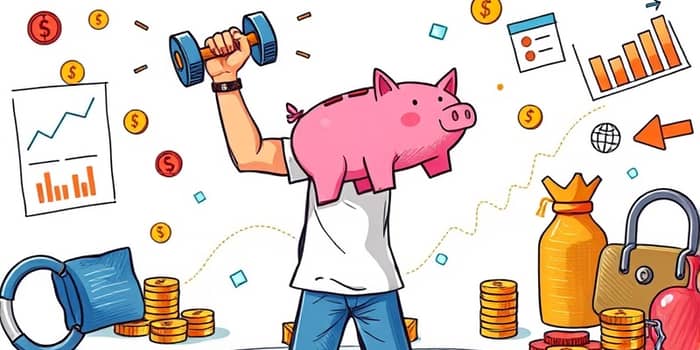In 2025, the concept of financial fitness as everyday discipline has gained momentum as more people recognize the parallels between a healthy body and a healthy bank account. This article explores habits that strengthen your wallet while nurturing discipline, resilience, and long-term security.
The Meaning of Financial Fitness
Financial fitness goes beyond having a budget or a retirement plan. It embodies a mindset of preparedness, accountability, and continuous improvement. Much like a well-structured workout regimen, it requires consistent effort, tracking progress, and adapting strategies over time.
When you approach your finances as a form of exercise, every saving or investment decision becomes an opportunity to build strength and endurance. Over time, these small routines compound into significant gains, promoting long-term wealth creation and security and reducing anxiety about unforeseen expenses.
By setting adult-friendly SMART objectives—Specific, Measurable, Achievable, Relevant, and Time-bound—you anchor your efforts in reality. For instance, aim to cut discretionary spending by 15% in three months or boost your emergency fund by $3,000 before year-end. This structure fosters accountability and motivation.
Why Physical and Financial Health Go Hand-in-Hand
Recent studies illustrate a powerful connection: among young people who exercise regularly, 92% have a financial plan versus only 54% among those who do not[1]. Those fit individuals tend to save twice as much and are less likely to miss payments on essential bills.
Exercise teaches goal setting, routine discipline, and the value of incremental progress—skills that effortlessly translate into sound money management. With a clear schedule for workouts, individuals learn to prioritize and stick to commitments, which can similarly be applied to budgeting and debt repayment.
Since 2020, the disciplined financial behaviors of younger cohorts have strengthened: 12% more 18–24-year-olds now carry credit cards responsibly, and missed payments have declined by 8% within this group[1]. This trend underscores how discipline learned from physical fitness can reshape financial habits for lasting stability.
The Latest Snapshot: How Healthy Are Americans’ Wallets?
In early 2025, 40% of Americans rated their finances as “fair,” 17% as “poor,” 36% as “good,” and just 7% as “excellent”[2]. Compared to last year, pessimism is rising: 28% now expect their financial situation to worsen, up from 16%.
Emergency savings remain a pressing concern. Only 48% of adults could cover three months of expenses if faced with job loss or medical bills[2]. For Generation Z, the figure is even lower at 45%, despite their proactive strides in other areas of money management.
Income clearly shapes confidence—those earning above the national median express greater financial resilience and a reduced sense of vulnerability to economic shifts such as inflation or potential recessions[2][3]. Addressing these gaps is vital to building a universally healthier financial outlook.
Barriers to Financial Health—and How People Are Overcoming Them
Economic challenges, particularly the high cost of living, remain significant barriers. Among Gen Z, 51% cite daily expenses as a hurdle: groceries (63%), rent and utilities (47%), and dining out (42%)[3]. These pressures can derail budgeting efforts and emergency savings goals.
Yet Gen Z demonstrates remarkable resourcefulness, with 72% taking concrete steps in the past year to shore up their finances—51% increased their savings rate, while 24% reduced their debt burden[3]. By forming peer accountability groups, sharing money-saving tips online, and using cash-back rewards, they show how communities can empower progress.
While 55% of Gen Z admit they lack a three-month buffer, their tendency to actively seeking financial independence and explore nontraditional income streams, such as freelancing or side businesses, highlights opportunities to overcome systemic cost pressures.
Budgeting: Still the Gold Standard for Financial Fitness
Budgeting remains the most effective tool to translate intentions into measurable outcomes. It provides clarity on income, sets spending boundaries, and highlights areas for potential savings. Data reveals that 83.1% of Americans use some form of budget, with 20.9% relying on specialized apps and others on spreadsheets or pen-and-paper methods[4][7].
- Track expenses daily to identify wasteful habits.
- Allocate funds into categories: needs, wants, and savings.
- Set spending thresholds and alert triggers for overspending.
- Regularly review and adjust allocations as income or goals change.
By treating your budget like a fitness tracker, complete with regular check-ins and progress reports, you maintain a clear view of your financial form and can pivot before setbacks become entrenched.
Technology’s Growing Role in Personal Money Management
Digital innovation is accelerating the financial fitness movement. From sleek smartphone apps to comprehensive online platforms, technology offers unprecedented insight and control. In 2025, nearly half of Americans leverage digital tools to oversee spending, set goals, and manage investments[4][7].
- Automated alerts for upcoming bills and low balances.
- Real-time budget dashboards that categorize transactions.
- Integration with investment portfolios for seamless fund allocation.
- AI-driven insights to highlight saving opportunities or risky patterns.
With expanding capabilities such as predictive analytics and customizable dashboards, these platforms empower users to act swiftly, optimize cash flow, and stay motivated through visual milestones.
Financial Literacy: Progress and Pitfalls in 2025
Although financial education requirements have tripled—27 states now mandate personal finance courses for high school graduation compared to 9 in 2020—U.S. adults still answer only 49% of basic financial literacy questions correctly[7]. This gap underscores the need for ongoing learning beyond formal education.
Social media offers a double-edged sword. Nearly 70% of Gen Z turn to TikTok or YouTube for money advice, gaining quick tips but risking exposure to oversimplified or unvetted strategies. Prioritizing reputable sources, such as certified financial planners or accredited online courses, ensures that learners build a robust foundation.
Mindfulness as a Money Habit
Financial mindfulness involves pausing to ask critical questions before spending: Does this purchase align with my values? Am I prioritizing long-term goals over short-term desires? Studies confirm that this approach leads to more disciplined spending and higher satisfaction with financial decisions[8].
Simple practices—such as maintaining a spending journal, setting weekly money check-ins, and visualizing future aspirations—help foster this habit. Over time, these mindful rituals become as automatic as breath control during meditation, guiding you away from impulsive purchases and toward intentional wealth-building.
Practical Steps and Habits for Building a Healthy Wallet
Turning knowledge into action requires a clear roadmap. Embrace the following habits to fortify your financial foundation:
- Set clear financial goals (short- and long-term), breaking them into manageable milestones.
- Automate your savings and investments effortlessly by using direct deposit or scheduled transfers.
- Build and maintain an emergency fund covering at least three months of living expenses.
- Pay more than the minimum on high-interest debt, focusing on the steepest rates first.
- Leverage technology and digital tools to monitor spending, receive alerts, and visualize progress.
- Commit to ongoing education through reputable books, courses, or consultations.
- Practice financial mindfulness every single day by reviewing transactions and reflecting on each expense.
- Reassess your plan quarterly, adjusting targets and strategies as life evolves.
What’s Next: Growing, Learning, and Thriving Financially
Financial fitness is a marathon, not a sprint. As you integrate these habits into daily life, celebrate progress, learn from setbacks, and stay connected with communities that support growth. Peer groups, online forums, or mentorship programs can provide accountability and fresh perspectives.
Ultimately, by blending structured budgeting, modern technology, continuous education, and a mindset of mindfulness, you cultivate a resilient financial framework. With each intentional action, you fortify not just your bank balance but your confidence and freedom to pursue life’s greatest ambitions.
References
- https://www.experianplc.com/newsroom/press-releases/2025/fit-and-financially-healthy--active-young-people-are-less-likely
- https://www.pewresearch.org/short-reads/2025/05/07/growing-share-of-us-adults-say-their-personal-finances-will-be-worse-a-year-from-now/
- https://newsroom.bankofamerica.com/content/newsroom/press-releases/2025/07/confronted-with-higher-living-costs--72--of-young-adults-take-ac.html
- https://www.academybank.com/article/banking-trends-in-2025-and-beyond-budgeting-apps-for-financial-success
- https://talkerresearch.com/how-people-plan-to-improve-their-money-habits-in-2025/
- https://www.pewresearch.org/short-reads/2024/12/09/roughly-half-of-americans-are-knowledgeable-about-personal-finances/
- https://carry.com/learn/how-financially-literate-is-america-key-stats
- https://www.georgetown.edu/news/this-money-habit-can-revolutionize-your-finances/










